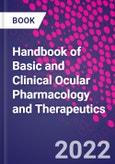Handbook of Basic and Clinical Ocular Pharmacology and Therapeutics provides a review of the basic anatomy, physiology, biochemistry and pathology of the eye with a focus drug therapy, drug delivery and use of therapeutic medical miniature devices. An understanding of the pharmacological actions of drugs acting on the eye requires the student and health care practitioner to learn additional principles in basic and clinical sciences that are unique to this organ. As a sensory organ, the eye is relatively inaccessible to the systemic circulation due to the blood-vitreous, blood-aqueous and blood-retinal barriers. Consequently, the administration of drugs for therapeutic effects in the eye necessitates an understanding of physico-chemical properties of the molecules and pharmacokinetic principles involved in the access to its site of action via topical, intracameral and intravitreal administration. This book includes information on the general principles of pharmacokinetics and pharmacodynamics of drugs as it pertains to the eye and in combating ocular disorders and diseases. Using a disease-themed approach, the book discusses basic and clinical pharmacological principles involved in the therapy of these diseases including the ocular side effect of systemically-administered drugs, drugs used in ophthalmic surgery and miscellaneous agents, the therapeutic utility of biologics, drug conjugates, combination products, gene and cellular therapy are also covered. Handbook of Basic and Clinical Ocular Pharmacology and Therapeutics is useful as a primary and secondary source of reference for up-to-date information about the pharmacological mechanisms of action, pharmacokinetics, side effects, drug-drug interactions and therapeutic indications of drugs for pharmacologists, pharmaceutical scientists, students in the health care disciplines (nursing, pharmacy, optometry, medical), and practitioners in optometry and ophthalmology.
Please Note: This is an On Demand product, delivery may take up to 11 working days after payment has been received.
Table of Contents
1. The Eye As A Target For Drugs2. Ocular Pharmacokinetics
3. Ocular Autonomic Pharmacology
4. Essential Pharmacology Of Drugs Relevant To The Eye
5. Drug Therapy Of Glaucoma
6. Drug Therapy Of Inflammatory Eye Diseases
7. Drug Therapy Of Retinal Diseases
8. Drug Therapy Of Ocular Allergies
9. Ocular Surface Diseases
10. Ocular Toxicology
11. Miscellaneous Agents








